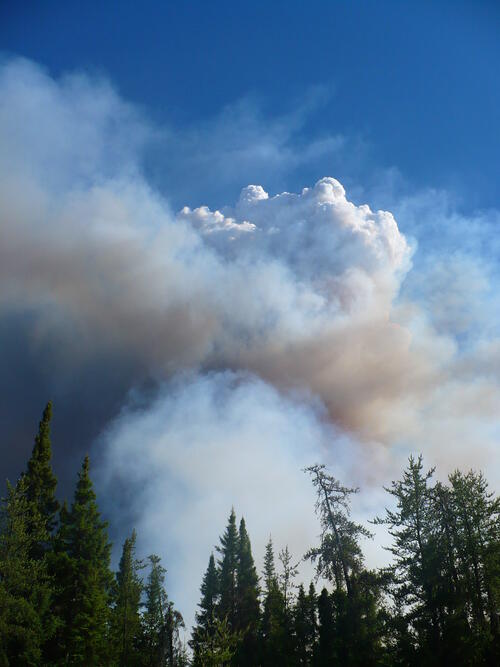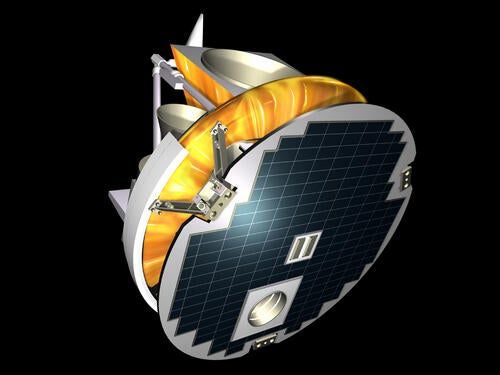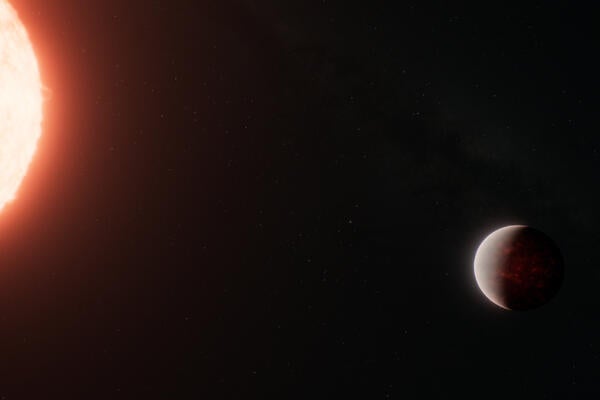
New research shows certain clouds remove air pollution from the surface of the Earth
Clouds draw pollution away from the surface of the Earth.

Clouds draw pollution away from the surface of the Earth.
By Media RelationsUsing data from the Canadian Space Agency’s (CSA) SCISAT satellite, atmospheric scientists from the University of Waterloo have confirmed that certain clouds draw pollution away from the surface of Earth.
By studying the air pollution that results from extreme fires like those seen in British Columbia and Australia and tracking the chemicals that they release, the team from Waterloo has confirmed that pyrocumulonimbus (pyroCb) clouds remove pollution into the stratosphere.
Forest fire air pollution takes the form of aerosols, small particles such as dust and smoke originating from both natural and human sources. They have a harmful impact on human health if found in high enough concentrations in the air people breathe, and also affect Earth’s surface temperature.
“These tall thunderclouds act like smokestacks that create a pathway for aerosols near the surface to be injected into the stratosphere. This is beneficial when it comes to the quality of the air that we breathe, but it’s important to note that these aerosols can still have repercussions on climate and atmospheric chemistry at higher altitudes,” said Chris Boone, the lead author of the study and project scientist on the SCISAT satellite at Waterloo.

Photo credit: Pyrocumulonimbus clouds courtesy of the Canadian Forest Service
Canada’s SCISAT is the only satellite in the world to measure 44 different atmospheric molecules and has more than 16 continuous years of trends in atmospheric composition.
“SCISAT is an outstanding achievement for Canadian science and industry. The scientific return on investment is greater than any other space mission. No other scientific satellite has such longevity and wide range of data products,” said Professor Peter Bernath, the Mission Scientist in charge of the research.
SCISAT measures ozone and ozone-depleting substances, as well as all major greenhouse gases – currently the only satellite with this performance. This basket of atmospheric gases includes over a dozen that are typically associated with biomass burning such as carbon monoxide, hydrogen cyanide, nitrogen dioxide, and methane.

Photo credit: SCISAT courtesy of the Canadian Space Agency
In this study, extreme fires in the US Pacific Northwest and in southern British Columbia during the summer of 2017, along with similar fires in southeast Australia in December 2019 through to January 2020, were identified as events that injected aerosols and many gases into the lower stratosphere.
“The stratospheric pollution can persist for months following these intense fire events, creating a significant impact on our atmospheric system,” said Chris Boone.
By analyzing these gas measurements as a function of altitude, the researchers found that concentrations of some gases increased by 50 percent over typical background levels and up to many orders of magnitude higher for others. Significant amounts of water vapour were found to be injected into the stratosphere, the atmospheric region where this molecule has a large greenhouse gas effect.
Also, enhanced levels of chlorine-containing molecules in the stratosphere were observed which are well-known to pose a risk to the ozone layer. This layer serves as a barrier to harmful UV radiation at the Earth’s surface and the substances that deplete this layer are regulated by the UN Montreal Protocol.
SCISAT has been monitoring ozone and ozone-depleting substances for its entire lifetime of nearly 17 years.
“Our study provides insight into the composition of stratospheric aerosols generated from these intense fires, which could help us further understand what role they ultimately play in our climate,” said Boone.
These spectral observations should be accounted for when considering the impact of aerosols on climate, on the evolution of high-altitude smoke plumes, and on modeling these atmospheric effects, say the researchers. A shifting climate could promote more frequent and more intense wildfires, creating the potential for a positive feedback loop, of particular concern for heavily forested regions such as those commonly found in Canada.
Canada’s SCISAT satellite is managed by the CSA and is operated from the Canadian Satellite Operations Centre in St-Hubert, Quebec; its atmospheric data products are developed by the Science Operations Centre at the University of Waterloo. The infrared spectrometer used was made by ABB Space and Defense Systems in Quebec City. The SCISAT satellite was built by Magellan Aerospace in Winnipeg, Manitoba and launched by NASA on August 12, 2003. Aug. 12, 2020 is the 17 year anniversary of SCISAT on orbit.
For more information, visit SCISAT’s website, The Atmospheric Chemistry Experiment’s website, and the study Pyrocumulonimbus Stratospheric Plume Injections Measured by the ACE‐FTS.

Read more
Here are the people and events behind some of this year’s most compelling Waterloo stories

Read more
Discovery of a thick atmosphere on a lava world reshapes our understanding of rocky exoplanets

Dr. Brian Dixon, professor of biology at the University of Waterloo says there is a link between cold weather and getting sick. (University of Waterloo)
Read more
Waterloo researcher shares why we get sick when the mercury dips
The University of Waterloo acknowledges that much of our work takes place on the traditional territory of the Neutral, Anishinaabeg, and Haudenosaunee peoples. Our main campus is situated on the Haldimand Tract, the land granted to the Six Nations that includes six miles on each side of the Grand River. Our active work toward reconciliation takes place across our campuses through research, learning, teaching, and community building, and is co-ordinated within the Office of Indigenous Relations.